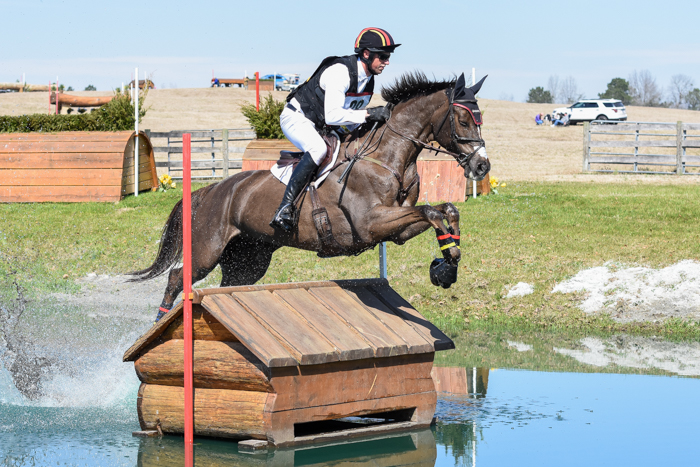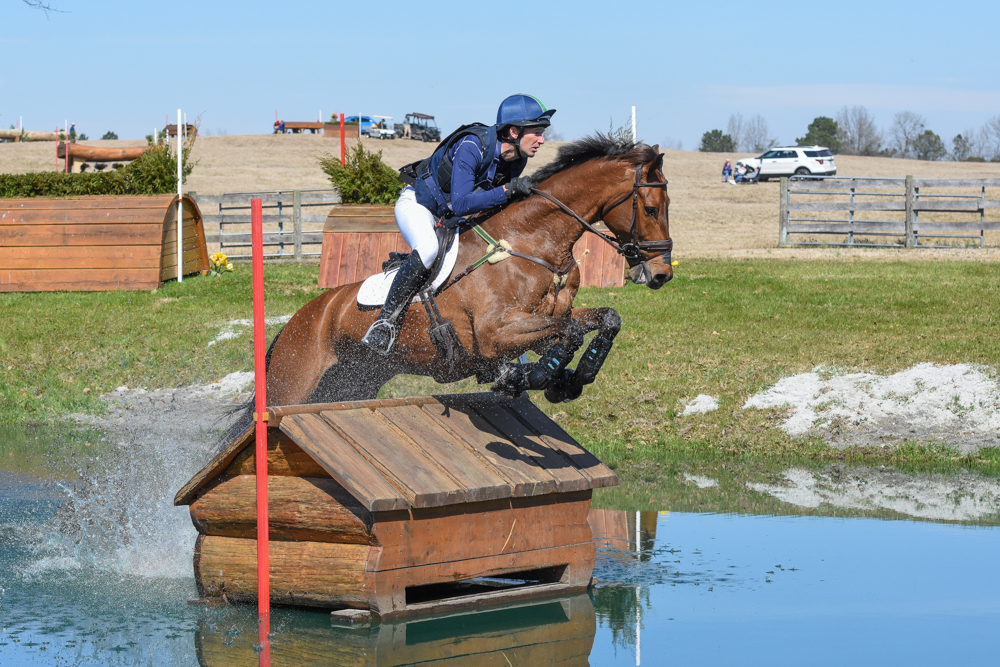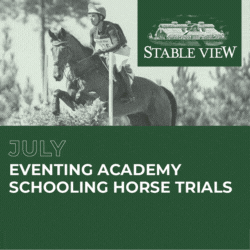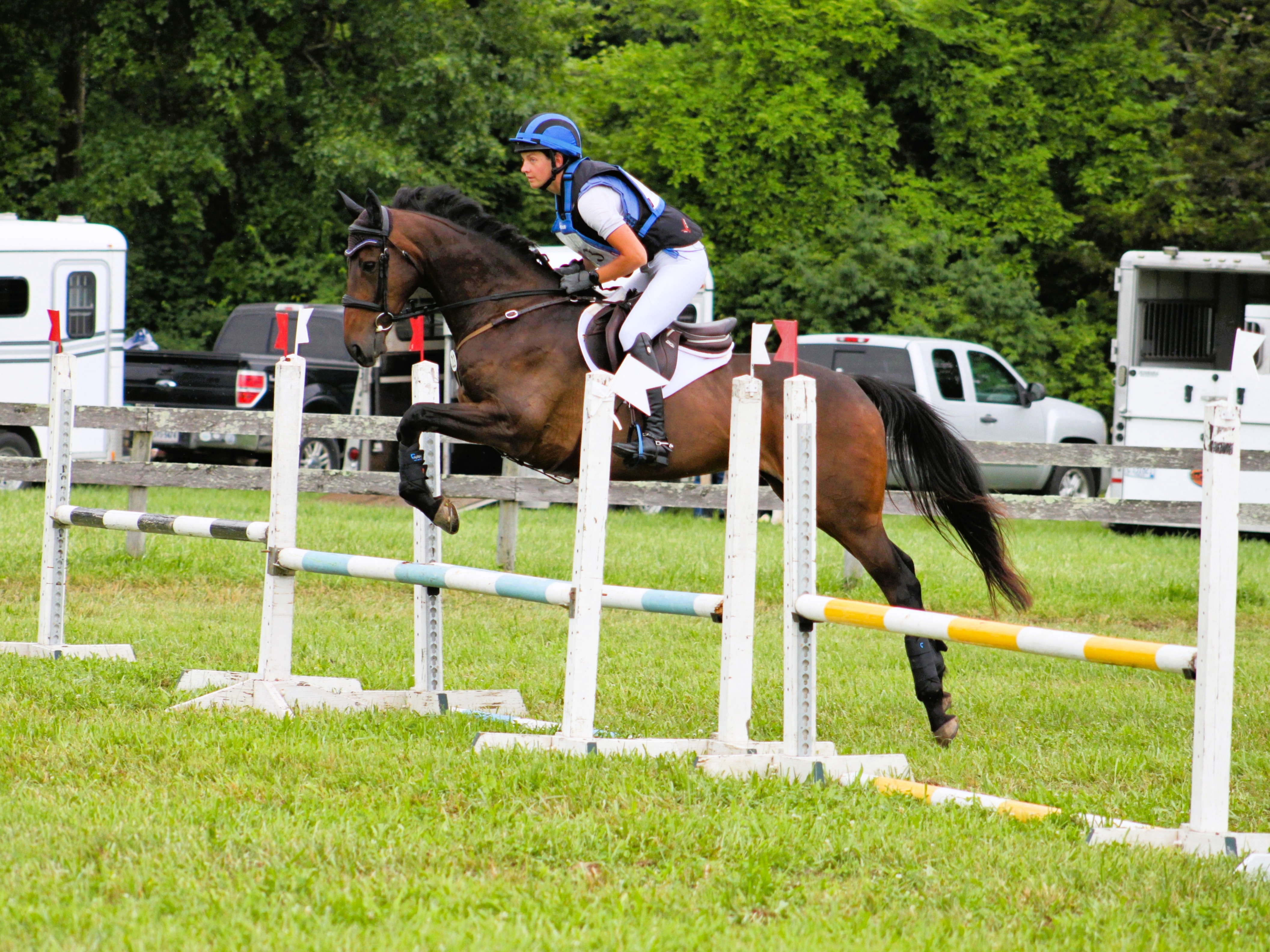A number of riders have shared with us their opinions about a recently proposed rule change by the USEA concerning the increased number of MERs to move up to Preliminary, Intermediate and Advanced. Michael Willham shares his perspective.

Photo courtesy of Michael Willham.
I think it is one thing to just “be an accountant” here and look at numbers, but an entirely different issue to then take your experience and think about how those numbers play out in the real world and how they may/may not be realistic.
I am writing this out of concern for the sport as well as the vast majority of people who make up the grassroots. As someone from Ohio who has ridden Prelim/Intermediate for the past five seasons, and frequently makes trips to the east coast, I think I have a decent view of both worlds: the professional programs of the east coast, but also the everyday realities of the grassroots and non-professionals. It seems to me that these rule changes didn’t take into account the non-professionals very well.
For clarification: I will be using “Prelim+” to signify any levels Prelim and above. I will also be assuming approximately 10 competitions a year, which I think is a very decent and packed year for most horses and most riders, and is at least average, or above average for most people who compete at the mid/upper levels without a string of horses. That would assume a competition every four weeks or so, starting in March and going through November. It also assumes every single one of those competitions achieves an MER, which isn’t super realistic.
Regarding licenses and the subsequent MERs to move up to Prelim+
As a quick summary, rules are being proposed to institute licenses based on someone’s experience. Licensed A riders have 25 MERs at Intermediate+, Licensed B riders have 25 MER’s at Prelim+, and everyone else is Unlicensed.
My concern comes in at how the rules then state how each of these three different categories qualify to run Prelim+.
I will bypass the Licensed A riders, as I think the proposed regulations are also reasonable, requiring essentially 3-4 MERs, without needing to be a combination to move up to any Prelim+ level. I think it is fairly safe and logical to assume someone who has successfully run around 25+ Intermediates has a fairly good handle on when they feel safe moving a horse up.
I will make a quick note for Unlicensed riders, which basically state they need 10 MERs at the previous level before moving up. Whether 10 is the exact right number is subject to some discussion, but I think you are at least in the general ballpark. I would say you are making a tremendous jump from the existing rule of four MERs (for anyone), to 10 MERs. But overall this issue I think is in the vicinity of acceptable and there should just be some discussion on the exact number. The only caveat would be a scenario in which someone has successfully run 20 Prelims, gets a new horse with Prelim+ experience, and has to run 10 Trainings as a combination before moving back up. That doesn’t make much sense, and we should be taking into account prior experience by stating that only maybe three of those 10 Training MERs have to come as a combination.
Instead, I want to focus on what these new rules mean for Licensed B riders. The rules basically take the above scenario and magnify it exponentially.
Under these new rules, Licensed B riders need seven MERs *as a combination* at the previous level in order to move up to any level Prelim+. (i.e. they need seven Training MERs as a combination to go Prelim, seven Prelim MERs to go Intermediate, etc.) Let me play out a scenario on why I think this is illogical and imposes overly harsh restrictions on people without adding much of any benefit to safety.
Keep in mind, Licensed B riders have successfully completed a *MINIMUM* of 25 Prelims. Potentially even more, and potentially others at Intermediate or even Advanced. I would say that they fall into the top 1% of riders out there today, and most people would look at them as fairly experienced, even if they aren’t the next Olympic hopeful. Also keep in mind that this is just counting MERs, while there are many instances where people come away with lots of experience from running a Prelim+ but just had a completely-safe mistake at a single fence, which means that most people have much more experience than just what their MERs show. I don’t think there are many people who run around Prelim+ for years and never come home with a 20, but yet they still gained valuable experience.
Scenario 1 – Jim Doe is a trainer who specializes in bringing young horses up to Prelim and typically selling them from there. He has successfully completed 60 Prelims and 15 Intermediates over the past four years with several different horses. I.e. he is fairly experienced at Prelim and Intermediate and knows what he is doing and when a horse feels ready. He gets a break with a horse he thinks is truly special and has some owners go in on buying the horse who has run around Intermediate for a year with a different rider but has the potential for more. Jim now has to take this horse to SEVEN Training level events, before being able to even get back to the level they are both easily experienced at. Essentially Jim loses almost an entire year of truly getting to know this horse at a competition with any real sort of challenge. I do not think many people would bat an eye at Jim taking the horse out to one or two Training Levels and then moving them back up to Prelim. Or potentially even starting him at Prelim since they both have a decent amount of experience. And I don’t think many people would say that would be unsafe, given their experience.
Scenario 2 – I will take this one even further within the specifications outlined in this rule:
Jane Doe has successfully completed 25 Prelims, eight Intermediates, and 10 Advanced with her horse. I.e., for someone to successfully run around eight Intermediates and 10 Advanced, she has spent very likely the last three years minimum going these levels after accounting for some competitions with jump penalties. She gets a new horse because her current one is getting old or isn’t able to take her past Advanced, but she has dreams of galloping around a 5*. This new horse is a seasoned 5* horse, having competed at five of them in the past few years, in addition to many Advanced, 4*s, etc.
However, because of this rule, as a Licensed B rider, Jane has to get seven MERs as a combination with this new horse. This means Jane, as a fairly experienced Intermediate/Advanced rider, with a 5* horse, needs to go to SEVEN Training level events before she is even allowed to go Prelim. (Can you imagine the ridiculousness of an Advanced level rider and a 5* horse having to gallop around not only one, but seven Training level events? Essentially about a whole season worth?)
Oh but she’s not done, now she also needs to go to SEVEN Prelim level events before she is allowed to go Intermediate. We’re now at 14 competitions, easily a minimum of a year and a half into their combination together and this Advanced level rider and 5* horse has just galloped through the flags of a Prelim.
And she’s still not done. Now they need another SEVEN Intermediates before going back to Advanced level.
Essentially, this Advanced level rider just wasted 21 competitions, easily at LEAST two years worth, but possibly three years, of competitions, her horse’s life/ability, and her time and money just to get back to the level she was originally competing at for over a year with a different horse. And that’s saying everything is perfect and she is able to attend every competition, 10 a year, without any abscesses, completely-safe mistakes, etc. This does not make any logical sense at all.
If you would allow, let me present a framework for a logical way to enact these proposed changes while keeping the majority of them the same.
I think the simplest way to get rid of these absolutely ridiculous real-life scenarios is to slightly modify the rule to better reflect prior experience. Essentially, we should be taking into account the fact that Licensed B riders could also have a plethora of experience that makes them knowledgeable about their and their horse’s capabilities even though they aren’t qualified for License A (after all, 25 successful Prelims+ is nothing to scoff at). Basically this revolves around the fact that the rules require them to obtain all of these MERs as a combination.
Regardless of the horse, it makes fairly logical sense that Unlicensed riders need to work up from Training. Although this would still be a little burdensome for them if they have successfully completed 30 Trainings and get a horse that has run around Prelim, and now they have to spend another 10 at Training? That also seems to be a little stretch. This issue gets magnified and explodes when you consider License B riders.
Here is what I think makes fairly logical and safe sense, while keeping the basis of the existing proposed framework. We can debate the exact number, but I think it is a fairly reasonable number.
For Unlicensed riders: A minimum of 10 MERs at the previous level to move up to each Prelim+ level. At least three of those must come as a combination.
For License B riders: A minimum of seven MERs at the previous level to move up to Intermediate or Advanced. At least 3 of those must come as a combination. For Prelim, a minimum of four MERs, not necessarily as a combination. (I am making Prelim the same as License A riders, because License B riders have enough experience to acknowledge when a horse is ready for Prelim, since they’ve successfully completed a minimum of 25 of them.)
This framework keeps the proposal’s way of classifying riders by experience (License levels), keeps the increased MER requirements for levels, but just adds the caveat which recognizes that experienced riders can be ready to safely take a horse at the upper levels a little earlier due to prior experience.
This mindset of accounting for prior other-horse experience is evident in the proposed rules for License A riders. The new rules don’t require them even having a single competition together, all qualifications can be separate. I say we allow for a step down from that for License B and Unlicensed riders, which requires a handful of combination MERs. Instead, the proposed rules goes from no-combinations required, to needing seven or 10, which I think is an extreme step, as outlined in the above scenarios.
I honestly shudder to think at what the current proposed rules would mean for anyone selling an upper level horse. The rules would make virtually all buyers who aren’t other professional riders take the horse Training Level. This would also be destroying the Young Rider program as many of them obtain mounts with more experience, but now they would be forced to spend a full season at Training Level.
All of these upper level horses who go for a “step-down” in their career to someone running Prelim or Intermediate would have a year or two of their life wasted running well below the level they and their new riders would realistically be capable of. And many of these upper level horses step down later in their careers, so taking two years to bring them up the levels limits a large chunk of their remaining viable years.
Regarding the general change to Appendix 3: “National levels at Preliminary and above, at least one of the required results must have been obtained within six weeks prior to the competition.”
There is unfortunately no more context to this, as it is stated right off the bat. How does this affect people who have already ridden at these Prelim+ levels? Is this qualification only for people (or combinations?) attempting to move up to this Prelim+ level for the first time? As it is currently written, this rule has none of these specifics. As it is written, this would imply that a 5* rider would need to take their 5* horse to Training level six weeks before attempting a Prelim? Obviously I know that is not the intent.
But let’s just move on and say that this rule is only for someone/combination moving up to any of the Prelim+ levels for the first time, which I think is the only semi-logical way to interpret this. But that still doesn’t seem to make much sense to me. Let me draw out a hypothetical, but easily common scenario:
Jane Doe has successfully gone Training level for the past 20+ competitions. She competes once a month and has competed in May. It is June and she is ready to move up to Prelim at her June horse trials. The day before leaving, her horse comes up with an abscess, causing her to scratch from her June horse trials. The horse recovers after a week and she spends the next month cross country schooling with her 5* instructor. Now this new rule would require her to make her August horse trial back at Training before even being allowed to attempt another Prelim? I don’t know if any experienced, safety-conscious 5* riders would even bat an eye at saying she is still good to go Prelim and that she is “unsafe” just because her last competition was two months ago instead of one month ago.
You would also have to take into account that, even barring small abscess-like scenarios such as this, not everyone is able to compete every six weeks. Someone might compete only every two to three months due to a number of personal reasons, but spends all of their time at home schooling and training the right way to move up to Prelim. But because of this rule, they are effectively shut out from ever competing at Prelim?
The logical, safety-conscious, experienced eventer would say that there are far too many scenarios that could be brushed off that prevent someone from getting a result six weeks prior, that ultimately have no effect on the safety of the combination moving up. I understand the intent behind trying to make sure people are prepared, but this rule may be preventing the *chance* of one ill-prepared rider having a bad injury/fall with this rule if they illogically attempt to move up to Prelim after six months off, but you are possibly preventing 100 other well-prepared riders from ever being able to move up. Of course I do not want anyone to ever get injured, but this rule is effectively closing the door to many people without a logical, realistic benefit to safety.
Perhaps the easiest way to amend this is to just extend the time frame (this is again assuming that this rule is only for people moving up to a level for the first time). Moving it to maybe a three-month time frame would I think be reasonable while also ensuring safety. That way it would prevent anyone from moving up to a new level at the first competition after the winter off-season (at least for those up north), and it would still have a recent-enough time frame to be safe but yet account for the chance of missing a competition and not being totally hung out to dry.




























































